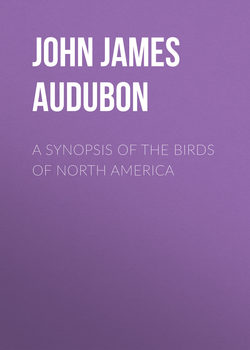Читать книгу A Synopsis of the Birds of North America - John James Audubon - Страница 7
FAMILY II. FALCONINÆ. FALCONINE BIRDS
GENUS IV. HALIAETUS, Savigny. SEA-EAGLE
ОглавлениеBill rather short, very deep, compressed; upper mandible with the dorsal outline nearly straight at the base, beyond the cere decurved, the sides sloping, the edges nearly straight, with a slight obtuse process, and a shallow sinus close to the strong trigonal tip; lower mandible, with the dorsal outline slightly convex, the tip obliquely truncate. Head large, oblong, flattened above. Nostrils oblong, oblique, near the ridge. Neck of moderate length. Body very large. Feet rather short, very robust; tarsi roundish, covered anteriorly with the transverse scutella, posteriorly with large, laterally with small scales; toes robust, free, scutellate above; claws large, curved, rounded, flat beneath, acuminate. Plumage compact, imbricated; feathers of the head and neck narrow and pointed; space between the bill and eye barish, being sparsely covered with bristle-like feathers, disposed in a radiating manner. Wings long, the second and third quills longest, the outer five cut out abruptly on the inner web. Tail rather long, rounded. Duodenum convoluted.
13. 1. Haliaetus Washingtoni, Aud. Washington Sea-Eagle
Plate XI. Male.
Tarsus and toes uniformly scutellate in their whole length. Bill bluish-black, cere yellowish-brown, feet orange-yellow, claws bluish-black. Upper part of the head, hind neck, back, scapulars, rump, tail-coverts, and posterior tibial feathers blackish-brown, glossed with a coppery tint; throat, fore-neck, breast, and belly light brownish-yellow, each feather with a central blackish-brown streak; wing-coverts light greyish-brown, those next the body becoming darker; primary quills dark brown, deeper on their inner webs; secondaries lighter, and on their outer webs of nearly the same light tint as their coverts; tail uniform dark brown.
Male, 43, 122.
From Louisiana northward. Exceedingly rare. The specimen figured procured in Kentucky. One seen in Labrador.
Bird of Washington, Falco Washingtonii, Aud. Orn. Biog. v. i. p. 58.
14. 2. Haliaetus leucocephalus, Linn. White-headed Sea-Eagle. – Bald Eagle
Plate XXXI. Adult Male. Plate CXXVI. Young.
Male. Tarsus with a few scutella; toes terminally scutellate. Male with the bill, cere, iris, and feet yellow; the head, the neck for half its length, the rump, upper and lower tail-coverts, and tail white; the rest of the plumage chocolate-brown, the terminal margins of all the feathers pale greyish-brown. Female similar. Young with the bill brownish-black, iris dark brown, feet yellow; the general colour of the plumage very dark chocolate, uniform, the feathers without edgings, all white at the base, that colour appearing more or less on the hind part, and more especially on the fore part and sides of the neck, and on the sides of the body and lower wing-coverts; quills and tail-feathers brownish-black, tinged with grey toward the base; the latter with the greater part of the inner webs, and a portion of the outer brownish-white, freckled with dusky. In more advanced stages the colours of the plumage vary considerably in different individuals. The general tint continues brown for several years, a variable and often a large proportion of white, or brownish-white, appearing on the neck, the lower part of the body, the sides, and under the wings, the tail meanwhile gradually becoming white in freckled patches, some have a large patch of brownish-white across the breast. When the feathers are new, they are of a glossy deep brown, but when old and worn they present a bleached appearance, and the upper parts are often patched with pale brown or brownish-white. On account of these circumstances, individuals of different ages, and shot at different periods of the year, differ so much from each other in appearance, that one might, without a very extended comparison, conceive that in a collection of specimens, there might be several species. The bill remains dark until the head and tail become white; the anterior tarsal scutella differ from none to six, the posterior from nine to twelve; those on the hind toe are four, on the middle toe from nine to thirteen.
Male, 34, 84.
Throughout North America. Resident in the south and west.
Bald Eagle, Falco Haliaetus, Wils. Amer. Ornith. v. iv. p. 89. Adult.
Sea Eagle, Falco ossifragus, Wils. Amer. Ornith. v. vii. p. 16. Young.
Falco leucocephalus, Bonap. Synops. p. 26.
Aquila leucocephala, White-headed Eagle, Swains. & Rich. F. Bor Amer. v. ii. p. 15.
White-headed or Bald Eagle, Falco leucocephalus, Nutt. Man. v. i. p. 72.
White-headed Eagle, Falco leucocephalus, Aud. Ornith. Biog. v. i. p. 160, v. ii. p. 160, v. v. p. 354.
